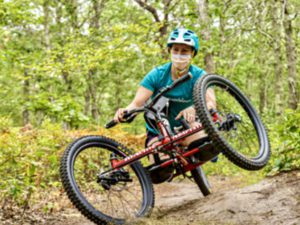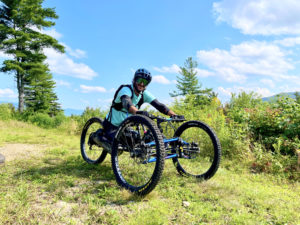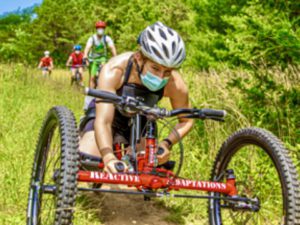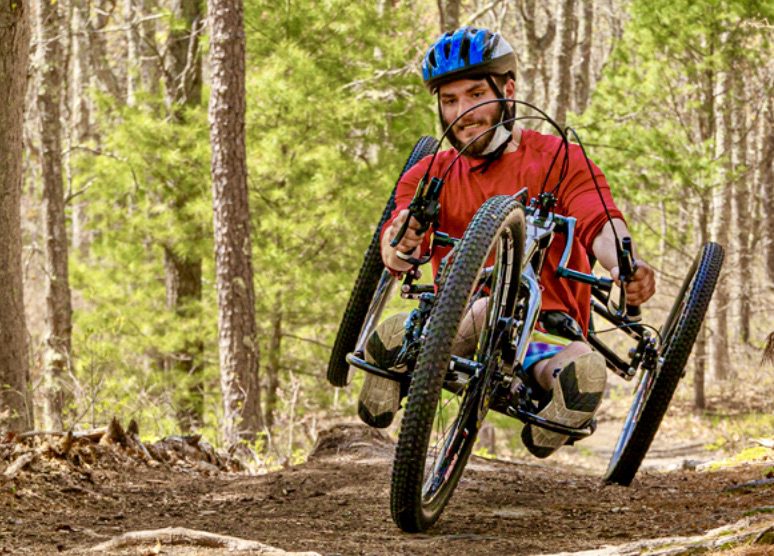By Michaela Lawlor and Bill Boles
This article first appeared in Singletrack, edition 166, Summer 2021, pages 7-11, published by NEMBA.org. It is now also available on our webpage with permission from Bill Boles.
Most mountain bikers would probably agree that there is no better feeling than the rush you get from cruising down singletrack in the woods. Mountain biking is a community sport that is enjoyed among friends and often strangers as well. Increasingly, more opportunities are becoming available for adaptive cyclists who enjoy mountain biking. The term adaptive may be new to some, so NEMBA would like to highlight what adaptive cycling is and how it promotes inclusivity for anyone with any ability level to be able to participate in the sport that so many of us love.
 Adaptive cycling and equipment can help people with varying physical, cognitive, and even emotional and behavioral disabilities. Some conditions include, but are not limited to paralysis, prosthesis, hearing impairment, visual impairment, multiple sclerosis, cerebral palsy, Parkinson’s disease, rheumatoid or psoriatic arthritis, traumatic brain injury, and post-traumatic stress disorder. There are several organizations now that are dedicated to adaptive sports and creating experiences for any and all people to get involved. Two specific organizations with which NEMBA has developed relationships are Vermont Adaptive Ski & Sports and Spaulding Adaptive Sports & Centers.
Adaptive cycling and equipment can help people with varying physical, cognitive, and even emotional and behavioral disabilities. Some conditions include, but are not limited to paralysis, prosthesis, hearing impairment, visual impairment, multiple sclerosis, cerebral palsy, Parkinson’s disease, rheumatoid or psoriatic arthritis, traumatic brain injury, and post-traumatic stress disorder. There are several organizations now that are dedicated to adaptive sports and creating experiences for any and all people to get involved. Two specific organizations with which NEMBA has developed relationships are Vermont Adaptive Ski & Sports and Spaulding Adaptive Sports & Centers.
In May, Cape Cod NEMBA hosted its first Adaptive Cycling Adventure in West Barnstable. Spaulding Adaptive Sports & Centers sponsored the ride and they provided five adaptive bikes for anyone to test.
 So what does adaptive cycling equipment look like? And how does it work? Recumbent trikes, where the rider is seated in a reclined position, is probably one of the more common types of adaptive cycling equipment. There are a few different types, including a delta trike where there are two wheels in the back and one in the front, or a tadpole trike with two wheels in the front and one in the back. They are both pedal operated and use hand levers that are situated on either side of the rider to steer. Hand cycles are another type of recumbent trike, usually a delta makeup in which the bike is completely operated by hand with levers. Some are power assisted, like e-bikes. Tandem bikes can be a great piece of adaptive cycling equipment for those who may be hearing or visually impaired. Tandem bikes allow for a guide to take the front seat and lead the way. Additionally, regular e-bikes can be used for adaptive cycling, too. For example, someone with Parkinson’s Disease or a breathing difficulty whose endurance is affected would benefit from an e-bike to give them the extra power to get up a hill, or through a more technical section of trail.
So what does adaptive cycling equipment look like? And how does it work? Recumbent trikes, where the rider is seated in a reclined position, is probably one of the more common types of adaptive cycling equipment. There are a few different types, including a delta trike where there are two wheels in the back and one in the front, or a tadpole trike with two wheels in the front and one in the back. They are both pedal operated and use hand levers that are situated on either side of the rider to steer. Hand cycles are another type of recumbent trike, usually a delta makeup in which the bike is completely operated by hand with levers. Some are power assisted, like e-bikes. Tandem bikes can be a great piece of adaptive cycling equipment for those who may be hearing or visually impaired. Tandem bikes allow for a guide to take the front seat and lead the way. Additionally, regular e-bikes can be used for adaptive cycling, too. For example, someone with Parkinson’s Disease or a breathing difficulty whose endurance is affected would benefit from an e-bike to give them the extra power to get up a hill, or through a more technical section of trail.
 Of course, not all disabilities are visible on the surface, so there is an element of awareness and understanding that comes along with adaptive cycling. There is some existing controversy over the use of e-bikes or other power-assisted trikes on trail systems in New England. There are often assumptions that e-bikes may damage trails more so than a typical mountain bike. However, an e-bike or an adaptive trike may be the New England Mountain Bike Association’s only feasible option for someone who faces challenges that would otherwise make cycling on a typical mountain bike difficult or even impossible.
Of course, not all disabilities are visible on the surface, so there is an element of awareness and understanding that comes along with adaptive cycling. There is some existing controversy over the use of e-bikes or other power-assisted trikes on trail systems in New England. There are often assumptions that e-bikes may damage trails more so than a typical mountain bike. However, an e-bike or an adaptive trike may be the New England Mountain Bike Association’s only feasible option for someone who faces challenges that would otherwise make cycling on a typical mountain bike difficult or even impossible.
This point is where the strength of the mountain biking community can really work its magic. Adaptive cycling is more than just occasional events or series – it is a constant. Those events are not the only time in which riders with disabilities want to enjoy mountain biking – they want to get out on a regular basis to enjoy their sport.
 In order for the trikes or tandem bikes to be used, trails have to be built to accommodate them. Usually, trails are benched eighteen to twenty-four inches wide for a regular mountain bike. In order to accommodate a trike, or a tandem bike that takes wider turns they would need to be wider. Additionally, the terrain of the trail would have to be flowier to ensure the safety and comfort of the rider. Lastly, three wheel adaptive bikes are longer and lower to the ground, so they can’t ride over tall stones.
In order for the trikes or tandem bikes to be used, trails have to be built to accommodate them. Usually, trails are benched eighteen to twenty-four inches wide for a regular mountain bike. In order to accommodate a trike, or a tandem bike that takes wider turns they would need to be wider. Additionally, the terrain of the trail would have to be flowier to ensure the safety and comfort of the rider. Lastly, three wheel adaptive bikes are longer and lower to the ground, so they can’t ride over tall stones.
NEMBA would like to continue to make adaptive cycling more widely available across all 29 of its chapters. We spoke with Vermont Adaptive Ski & Sports in April about their experiences working with adaptive athletes. Kim Jackson, the Director of Communications and Marketing told us, “Once you introduce adaptive equipment, it equalizes everything. Adaptive athletes can then get outside to play with everybody.”
 Part of building mountain bike trails is testing them out to see how they ride. It helps builders to visualize what additional adjustments need to be made to make the trail the best it can be. Felicia Fowler, the Program Coordinator at Vermont Adaptive Ski & Sports added in Killington, Vermont and Spaulding Adaptive Sports & Centers serves the North Shore, Boston, and Cape Cod areas.
Part of building mountain bike trails is testing them out to see how they ride. It helps builders to visualize what additional adjustments need to be made to make the trail the best it can be. Felicia Fowler, the Program Coordinator at Vermont Adaptive Ski & Sports added in Killington, Vermont and Spaulding Adaptive Sports & Centers serves the North Shore, Boston, and Cape Cod areas.
Together we can make a difference and help every one of every ability enjoy mountain biking! that the builders in their area working on trails to accommodate adaptive bikes got on adaptive bikes to test the trails out. The act of immersion can help us better understand the equipment and the experiences adaptive cyclists have using it.
If you are hosting a cycling event and you are interested in providing adaptive equipment for people to use, you can get in touch with the nearest adaptive sports organization to you. Vermont Adaptive Ski & Sports is based in Killington, Vermont and Spaulding Adaptive Sports & Centers serves the North Shore, Boston, and Cape Cod areas. Together we can make a difference and help every one of every ability enjoy mountain biking.
Where to ride an Adaptive Mountain Bike in New England:
The Kingdom Trails Association is working with Vermont Adaptive and the Kelly Brush Foundation to evaluate its trails for adaptive access and to make some modifications to appropriate trails. Vermont Adaptive has also been working with Stowe Trail Partnership to build inclusive mountain biking trails at Cady Hill. Read more about that here.
For the list of adaptive trails, for guidance or information about adaptive cycling, and how you can get involved, please refer to the original article.
FOR MORE INFORMATION ABOUT ADAPTIVE BIKING VISIT
https://www.rad-innovations.com/blog-our-news/what-is-an-adaptive-bike

